| Listing 1 - 9 of 9 |
Sort by
|
Book
ISBN: 1863681094 Year: 1995 Publisher: South Terrace : Fremantle Arts Centre Press,
Abstract | Keywords | Export | Availability | Bookmark
 Loading...
Loading...Choose an application
- Reference Manager
- EndNote
- RefWorks (Direct export to RefWorks)
Account of the events that led to the Forrest River massacre of 1926 and the Royal Commission that followed; account of the frontier violence and earlier massacres in the region; efforts of Ernest Gribble to obtain justice.
Aboriginal Australians --- Massacres --- Aborigènes d'Australie
Book
ISBN: 0702227293 Year: 1995 Publisher: St. Lucia : University of Queensland Press,
Abstract | Keywords | Export | Availability | Bookmark
 Loading...
Loading...Choose an application
- Reference Manager
- EndNote
- RefWorks (Direct export to RefWorks)
Aboriginal Australians --- Aboriginal Australians --- Aboriginal Australians --- Torres Strait Islanders --- Torres Strait Islanders --- Torres Strait Islanders --- Aborigènes d'Australie --- Militants politiques --- Political activists --- Land tenure. --- Civil rights. --- Government relations. --- Land tenure. --- Civil rights. --- Government relations. --- Droits.
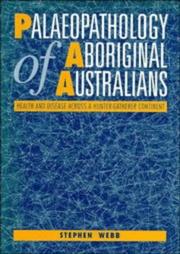
ISBN: 0521460441 0521110491 0511552181 0511885075 Year: 1995 Publisher: Cambridge : Cambridge University Press,
Abstract | Keywords | Export | Availability | Bookmark
 Loading...
Loading...Choose an application
- Reference Manager
- EndNote
- RefWorks (Direct export to RefWorks)
While their health has suffered enormously because of the arrival of the Europeans, it is assumed that Aboriginal people enjoyed good health before 1788. Using data collected from all parts of the continent, this 1995 book studies the health of Australia's original inhabitants over 50,000 years. It represents the first continental survey of its kind and is the first to quantify and describe key aspects of Australian hunter-gatherer health. The book takes a theoretical approach to Upper Pleistocene regional epidemiology and presents empirical data of the health of late Pleistocene and Holocene populations. Major categories of disease described are: stress, osteoarthritis, fractures, congenital deformations, neoplasms and non-specific and treponemal infections. The author also describes surgical techniques used by Aboriginal people. Offering fresh insight into the study of Australian prehistory and Aboriginal culture, this book will be accessible to specialists and general readers alike. It illuminates the origins of human disease, and will fill a gap in our knowledge of health in the Australasian region.
Aboriginal Australians --- Paleopathology --- Health and hygiene. --- Social Sciences --- Anthropology --- Medical archaeology --- Pathology
Book
ISBN: 0731521714 Year: 1995 Publisher: Darwin Australian Nature Conservation Agency
Abstract | Keywords | Export | Availability | Bookmark
 Loading...
Loading...Choose an application
- Reference Manager
- EndNote
- RefWorks (Direct export to RefWorks)
Aboriginal Australians --- National parks and reserves --- Natural history --- Management --- Kakadu National Park (N.T.)
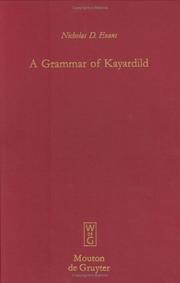
ISBN: 3110127954 3111802515 3110873737 9783110873733 Year: 1995 Volume: 15 Publisher: Berlin De Gruyter
Abstract | Keywords | Export | Availability | Bookmark
 Loading...
Loading...Choose an application
- Reference Manager
- EndNote
- RefWorks (Direct export to RefWorks)
Australian languages --- Grammar --- Aboriginal Australians --- Gayardilt language --- Gajadilt language --- Gajardild language --- Gayadilt language --- Kaiadilt language --- Kayardild language --- Malununda language --- Tangic languages --- Aboriginals, Australian --- Aborigines, Australian --- Australian aboriginal people --- Australian aboriginals --- Australian aborigines --- Australians, Aboriginal --- Australians, Native (Aboriginal Australians) --- Native Australians (Aboriginal Australians) --- Ethnology --- Indigenous peoples --- Languages&delete& --- Languages --- Grammar.
Book
ISBN: 0874211980 0874211875 9786613077974 0874213754 1283077973 9780874213751 9781283077972 9780874211986 9780874211870 9780874211986 Year: 1995 Publisher: Logan, Utah Utah State University Press
Abstract | Keywords | Export | Availability | Bookmark
 Loading...
Loading...Choose an application
- Reference Manager
- EndNote
- RefWorks (Direct export to RefWorks)
Where it divides Arizona and Sonora, the international boundary between Mexico and the United States is both a political reality, literally expressed by a fence, and, to a considerable degree, a cultural illusion. Mexican, Anglo, and Native American cultures straddle the fence; people of various ethnic backgrounds move back and forth across the artificial divide, despite increasing obstacles to free movement. On either side is found a complex cultural mix of ethnic, religious, and occupational groups. In A Shared Space James Griffith examines many of the distinctive folk expres
Aboriginal Australians -- Attitudes. --- Aboriginal Australians -- Government relations. --- Aboriginal Australians, Treatment of. --- Australia -- Race relations. --- Regions & Countries - Americas --- History & Archaeology --- United States Local History --- Folklore --- Borderlands --- Arizona --- Sonora (Mexico : State) --- Social life and customs. --- Border-lands --- Border regions --- Frontiers --- Folk beliefs --- Folk-lore --- Traditions --- Sonora, Mexico --- Gobierno del Estado de Sonora (Mexico) --- State of Arizona --- Ariz. --- أريزونا --- Ārīzūnā --- Estato d'Arizona --- Штат Арызона --- Shtat Aryzona --- Арызона --- Aryzona --- AZ --- Аризона --- Talaith Arizona --- Hoozdo Hahoodzo --- Arizona osariik --- Αριζονα --- Πολιτεία της Αριζόνα --- Politeia tēs Arizona --- Estado de Arizona --- Arizono --- Â-li-sông-ná --- ʻAlikona --- Negara Bagian Arizona --- Aariisuunaa --- Civitas Arizonae --- アリゾナ州 --- Arizona-shū --- アリゾナ --- Statul Arizona --- Arizona Eyâleti --- Штат Аризона --- Territory of Arizona --- Arizona Territory --- Arizona (Ter.) --- Boundaries --- Ethnology --- Manners and customs --- Material culture --- Mythology --- Oral tradition --- Storytelling --- Occidente (Mexico)
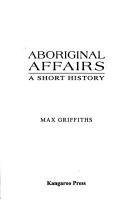
ISBN: 0864177291 Year: 1995 Publisher: Kenthurst, New South Wales : Kangaroo Press,
Abstract | Keywords | Export | Availability | Bookmark
 Loading...
Loading...Choose an application
- Reference Manager
- EndNote
- RefWorks (Direct export to RefWorks)
Popular account of Indigenous affairs; policies of the Governors and the British Parliament; conflict with pastoralists; protection policy; missions; founding of the Commonwealth of Australia; Bleakley report and the conference on Aboriginal affairs of 1929, and its impact on welfare legislation passed in the 1930s; effects of World War 1 on policy; formal recognition of Aborigines by the Commonwealth in 1948 through the Nationality and Citizenship Act, when Aborgines were declared British subjects and Australian citizens; Paul Hasluck as Minister for Territories; 1961 state and federal ministers' conference on Aboriginal affairs; 1967 referendum and the attitudes of politician's of the time to Aboriginal affairs; policy of self-determination; land rights; Aboriginal affairs in Queensland during Whitlam and Fraser years; Noonkenbah; rise of the 'black bureaucracy'; 'Foundations for the Future' policy of the bicentennial year, which included social justice policy and the creation of ATSIC; Royal Commission into Aboriginal Deaths in Custody; Mabo decision in 1992; race relations.
Aboriginal Australians --- Aboriginal Australians --- Aborigènes d'Australie --- Aborigènes d'Australie --- Government policy - Assimilation - 1951-1971. --- Religions - Christianity - Missions. --- Government policy - Assimilation. --- Government policy - Assimilation - 1926-1950. --- Government policy - Self determination. --- Government policy - Initial period and protectionism. --- Politics and Government - Political parties. --- Land rights. --- Government policy - Initial period and protectionism - 1788-1850. --- Colonisation. --- Government policy - Self determination - 1993-2004. --- Government policy - Self determination - 1972-1984. --- Government policy - Self determination - 1985-1992. --- Government policy - Initial period and protectionism - 1901-1925. --- Government policy - Initial period and protectionism - 1851-1900. --- Social conditions. --- Government relations --- History. --- Relations avec l'État --- Histoire. --- Conditions sociales. --- Queensland (Qld) --- Northern Territory (NT) --- Noonkanbah / Yungngora (WA West Kimberley SE51-12) --- Australia.
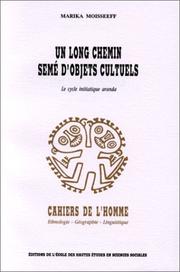
ISBN: 2713211905 9782713211904 Year: 1995 Volume: nouv. sér., 33 Publisher: Paris : Ecole des Hautes Etudes en Sciences Sociales - EHESS,
Abstract | Keywords | Export | Availability | Bookmark
 Loading...
Loading...Choose an application
- Reference Manager
- EndNote
- RefWorks (Direct export to RefWorks)
Aranda (Australian people) --- Aranda (Peuple australien) --- Kinship. --- Psychology. --- Religion --- Rites and ceremonies. --- Parenté --- Psychologie --- Rites et cérémonies --- -Aranda (Australian people) --- -Aranda tribe --- Aranta (Australian people) --- Arunndta (Australian people) --- Arunta (Australian people) --- Aboriginal Australians --- Ethnology --- Kinship --- Psychology --- Rites and ceremonies --- -Kinship --- Parenté --- Rites et cérémonies --- Aranda tribe --- Aranda (Australian people) - Psychology. --- Aranda (Australian people) - Rites and ceremonies. --- Aranda (Australian people) - Kinship. --- ARANDA (PEUPLE D'AUSTRALIE) --- RITES D'INITIATION --- AUSTRALIE
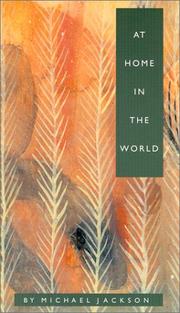
ISBN: 0822325381 0822315610 9780822315612 0822315742 0822396122 9780822325383 Year: 1995 Publisher: Durham Duke University Press
Abstract | Keywords | Export | Availability | Bookmark
 Loading...
Loading...Choose an application
- Reference Manager
- EndNote
- RefWorks (Direct export to RefWorks)
Ours is a century of uprootedness, with fewer and fewer people living out their lives where they are born. At such a time, in such a world, what does it mean to be "at home?" Perhaps among a nomadic people, for whom dwelling is not synonymous with being housed and settled, the search for an answer to this question might lead to a new way of thinking about home and homelessness, exile and belonging. At Home in the World is the story of just such a search. Intermittently over a period of three years Michael Jackson lived, worked, and traveled extensively in Central Australia. This book chronicles his experience among the Warlpiri of the Tanami Desert.Something of a nomad himself, having lived in New Zealand, Sierra Leone, England, France, Australia, and the United States, Jackson is deft at capturing the ambiguities of home as a lived experience among the Warlpiri. Blending narrative ethnography, empirical research, philosophy, and poetry, he focuses on the existential meaning of being at home in the world. Here home becomes a metaphor for the intimate relationship between the part of the world a person calls "self" and the part of the world called "other." To speak of "at-homeness," Jackson suggests, implies that people everywhere try to strike a balance between closure and openness, between acting and being acted upon, between acquiescing in the given and choosing their own fate. His book is an exhilarating journey into this existential struggle, responsive at every turn to the political questions of equity and justice that such a struggle entails.A moving depiction of an aboriginal culture at once at home and in exile, and a personal meditation on the practice of ethnography and the meaning of home in our increasingly rootless age, At Home in the World is a timely reflection on how, in defining home, we continue to define ourselves.
Walbiri (Australian people) --- Philosophy, Walbiri. --- Home --- Homelessness --- Social conditions. --- Philosophy. --- Warlpiri (Australian people) --- Philosophy, Warlpiri. --- Elpira (Australian people) --- Ilpara (Australian people) --- Ngaliya (Australian people) --- Ngardilpa (Australian people) --- Walbiri tribe --- Walmama (Australian people) --- Walpiri (Australian people) --- Warlbiri (Australian people) --- Warnayaka (Australian people) --- Warrmarla (Australian people) --- Aboriginal Australians --- Ethnology --- Families --- Marriage --- Housing --- Poverty --- Homeless persons --- Philosophy, Walbiri --- Warlpiri philosophy --- Walbiri (Australian people) - Social conditions. --- Home - Philosophy. --- Homelessness - Philosophy.
| Listing 1 - 9 of 9 |
Sort by
|

 Search
Search Feedback
Feedback About UniCat
About UniCat  Help
Help News
News